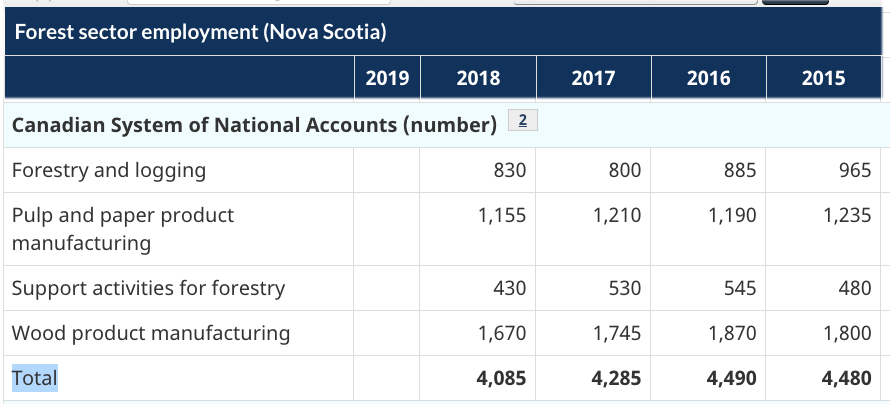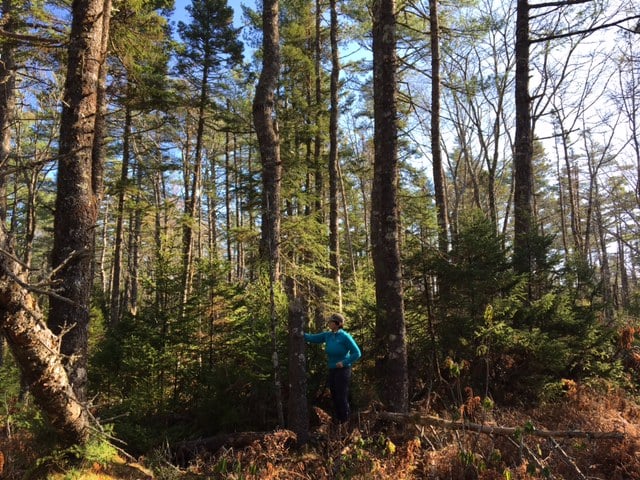
Surely it’s remarkable when we step back and think about it, that an industry contributing less than 0.5% to our GDP is permitted to lay waste to the landscape on such a massive scale. Will a PC Government finally put an end to it?
An ad by Forest NS in Saturday’s Chronicle Herald prompted me to check some stats. Forestry’s role in Nova Scotia’s economy is far from enough, it would appear, to justify further subsidy of Big Forestry by allowing our most productive Crown lands to be clearcut and managed – with the taxpayer’s assistance – as plantations. Our forests are now seriously degraded by centuries of excessive harvesting and by human-set fires (up to about 1980), and in the latter 20th century by acid rain on the inherently poor soils that cover more than 60% of the NS landscape. The truth of the matter is that in 2021 we need our forests more than we need Big Forestry. For the sake of the forests themselves, for biodiversity conservation, to do our part to slow climate warming, and to allow the use and enjoyment of our Crown land forests by all Nova Scotians, it is time to reduce the wood supply from Crown land and to permit only ecological forestry on Crown lands. For the sake of our economy, the taxpayers and private woodlot owners who deserve a fair price for their wood, it is time to stop subsidizing Big Forestry via their privileged access to our best remaining Crown land forests
————–
UPDATE Sep 7, 2021. Commenting on this post on WWNS (copied below), JW suggested that the discrepancy in employment in the forestry sector between Tables 1 and 2 below is likely explained by the category Wood Product Manufacturing which is included in Table 1 in the calculation of total employment in the “Forest Sector” but was probably not included under “Forest Logging and support activities” in Table 2. I think he is right. I have modified some of my comments and estimates accordingly.
————–
No surprise, I guess, to view an ad by Forest NS in the Chronicle Herald Saturday ed. that reads:
Let’s Get Growing Together
Congratulations to Nova Scotia’s New Government and Premier Tim Houston.
There is lots of work to do to improve healthcare and provide economic opportunities throughout our province.
Nova Scotia’s forestry sector is ready to help.
We welcome the new Minister of Natural Resources and Renewables, the Hon. Tory Rushton. He appreciates the vital role that forestry can play in keeping our environment healthy and economy strong.
We will work with your government to;
• Grow the forestry sector sustainably
• Implement the Lahey Report on Crown Land in its entirety
• Care for our forests’ health and diversityNova Scotia’s 10,000 forestry workers and 30,000 plus woodlot owners support our forests by nurturing this abundant natural resource for today and tomorrow.
Together, we can ensure that forestry, farming and fishing lead Nova Scotia to a rural revitalization based on managing our renewable resources responsibly for stronger, healthier communities.
wwwforestns.ca
Forest Nova Scotia NOVA SCOTIA NEEDS FORESTRY
I wondered about the stats, however.
According to Stats-Canada, the Forest sector employment for Nova Scotia is less than half of the number cited by Forest NS:
Table 1
Then I wondered what proportion of the workforce is accounted by forestry and support activities for forestry? As a back-0f-the envelope estimate, I assume that the population, 979,115 , is close to 1 million; if half of the people are in the workforce that would be 500,000, and if there are 5000 workers in forestry and forestry support industries, that would amount to 1% of total employment. So the proportion of the workforce accounted by forestry and support activities for forestry should be in that ballpark, one would think.
This is what StatCan offers:
(multiply numbers in the table by 1000 for the actual numbers; click on image for source)
Table 2
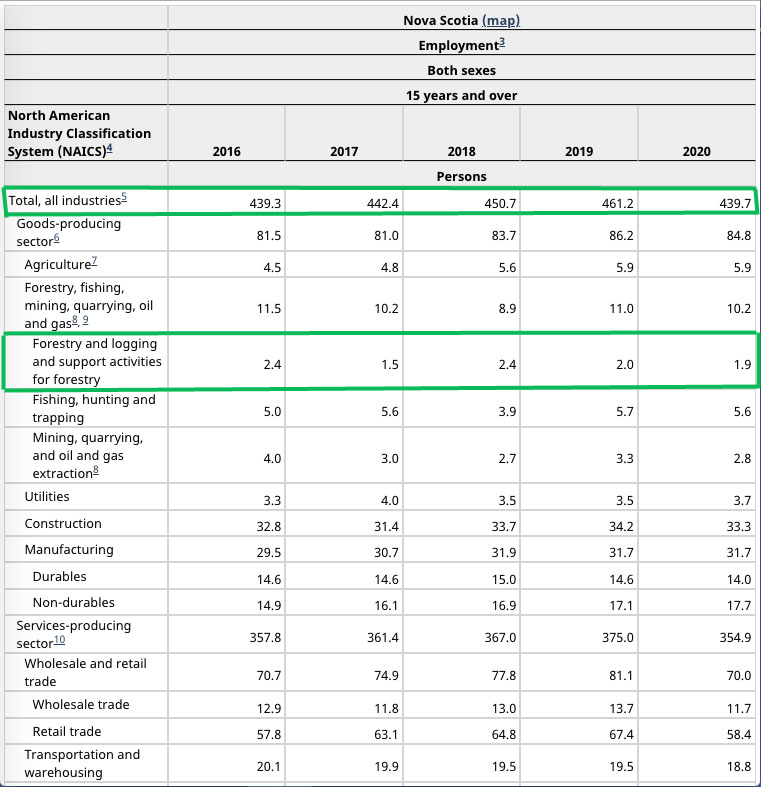

In this StatCan rendition of the stats, employment in forestry and forestry support industries is only 1900 people (versus 4085 cited in the previous table)* and the proportion of total employment as a percent is 0.43%; if it were 4085 people, the percentage would be 0.92%’ if it were 10,000 people as Forest NS claims, it would be closer to 2%.
*The discrepancy is likely explained by the category Wood Product Manufacturing which is included in Table 1 in the calculation of total employment in the “Forest Sector” but was probably not included under “Forest Logging and support activities” in Table2. Thx to JW for this possible explanation of the discrepancy; it was offered in a discussion in social media – see below
So what about Forestry’s contribution to the GDP? Here are some more StatCan numbers:
Table 3
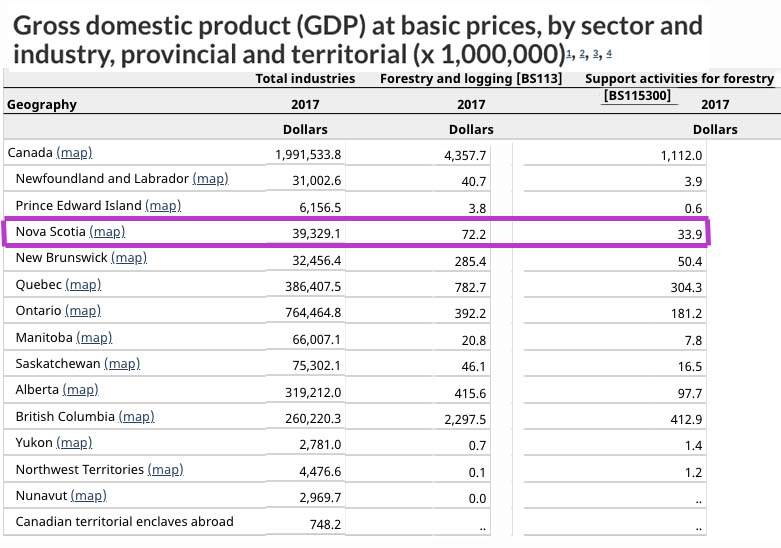
So (72.2+33.9)/39329 x 100 = 0.27%, or numerically, approximately half of the employment percent. Apparently one forestry worker generates half of the average revenue per worker in NS. If we use the Forest NS figure for employment, the revenue per worker is very much lower- another indication that the Forest NS figure is highly exaggerated. Wood Product Manufacturing is probably not included the calculation of the contribution of forestry and support industries GPP; if it were, the percentage would be closer to 0.5%.
At 1% or less of total employment, it seems clear that while forestry is important as employer in rural NS, in 2021 it is not a very significant employer for NS as a whole.
Forestry’s contribution to the GDP is even smaller,
So… we might keep those numbers in mind when Forest NS talks about the “vital role that forestry can play in keeping our environment heathy and economy strong”.
At something less than 1% of GDP, it is surely not ‘vital’ to the NS economy.
And what about Big Forestry’s role “in keeping our environment heathy”?
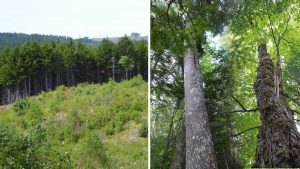
Two woodlots in Nova Scotia, one involving clearcut forestry and promoting softwoods, the other involving selection management and maintaining a mixed, multi-aged Acadian forest.
Nova Scotia’s forests are now seriously degraded by centuries of excessive harvesting and by human-set fires (up to about 1980), and in the latter 20th century by acid rain on the inherently poor soils that cover more than 60% if the NS landscape. (View or search pages and posts on this website for more on these topics.)
Forest NS says they will work with government to “implement the Lahey report in its entirety” and to “care for out forests health and diversity”.
Somehow or another in the dying days of the Liberal Government, Forest NS & Co. became fans of the Lahey Report. That’s after 3 years of saying nothing while pretty well the status quo continued on Crown lands, or really 11 years if we go back to the Natural Resources Strategy of 2010. (Forest NS had plenty to say behind closed doors about the forestry recommendations coming out of the Natural Resources Strategy).
And look what the Lahey recommendations could potentially give to Big Forestry*: access to the most productive forest stands remaining on Crown land, which they can clearcut, spray and manage as plantations, very likely with NS taxpayers paying most of the costs.
*Big Forestry: those companies holding a FULA (Forest Utilization License Agreement) or are in the WestFor consortium and which are highly dependent on clearcutting, economies of scale and a Forest NS-friendly provincial government to survive.
Somehow or another the question of how much Crown land would come under High Production Forestry was never forecast publicly in the Rankin days.
Forgive me if I speculate that in private, Forest NS & Colleagues were being reassured by Rankin that the supply of wood from Crown lands would not be reduced. In fact Rankin said just that in his first formal comment on the Lahey Recommendations as Minister of Lands & Forestry – he actually said he disagreed with Lahey on that point. From a CBC report on Dec 3, 2018:
Lahey said he was pleased overall with the government’s plan, but had hoped to see more detail in response to his report.
“I would have liked for a little bit more boldness in terms of what they think they can accomplish, particularly in reducing the amount of clear cutting on Crown land.”
...And while Lahey predicted less clear cutting would lead to a reduction of Crown land wood supply of 10 to 20 per cent, Rankin disagreed.
“We believe that we can sustainably grow this industry.”
We still have not seen the numbers to back up this claim. If it’s not valid (& it likely isn’t) and indeed, wood supply from Crown lands is not reduced, then very clearly we will be continuing on the ecologically destructive path followed since the settlers arrived in NS and a lot of the little that is left of healthy mature forests will be gone in 10-20 years.
So much for the healthy environment’ part of Forest NS’s messaging.
We wouldn’t pay a big price by greatly reducing intensive forestry
Surely it’s remarkable when we step back and think about it, that an industry contributing less than 0.5% to our GDP* is permitted to lay waste to the landscape on such a massive scale.
*If clearcutting/even-aged forestry is eliminated, that would affect a portion of GDP attributed to forestry and support industries, not the whole of it. As Wood Product Manufacturing would still go on – already much or most lumber is imported to NS – so the immediate loss would be something less than 0.27% (by StatCan numbers), let’s say half of it, i.e. about 0.14%. It can be envisaged that many of the remaining smaller scale forest enterprises would adapt and grow through increased demand, and more non-timber forestry activities would become possible.
Surely in 2021, the dual and linked climate and biodiversity crises behoove us to be much more caring about the impact of forestry on the NS landscape and on ecosystems services such as carbon storage and biodiversity and public health than we have in the past.
To do so, we must greatly reduce intensive forestry – i.e. clearcutting/even aged management – on Crown and private lands.
Fortunately, we have many individual foresters and contractors operating on smaller scales than Big Forestry who are already skilled in ecological forestry methods.
The good news from the economic stats is that greatly reducing intensive forestry would have a very small impact, if any, on our GDP. Over the long run such a reduction would probably benefit it, e.g., by keeping NS a place where people want to live and by reducing loss of ecological services. That sounds like something a Progressive Conservative government could support.
Let’s hope so.
Some related posts on NSFN
Finally, some numbers on the cost of High Production Forestry in Nova Scotia 1Aug2021
Post, Aug 1, 2021 “It seems that over a full rotation, the costs of HPF approach or exceed the profits; Greg Watson asks “who’s going to pay for it, and if it’s the taxpayer, are they willing to foot the bill? “
Is High Production Forestry compatible with the Nova Scotia Premier’s commitment to carbon neutrality? 11Mar2021
Post, Mar 11, 2021 “Simply put, one cannot make the assumption that “implementing the Lahey recommendations” will help to mitigate climate change”
Forest Nova Scotia’s “simple math” underscores key issue for success or failure of Government’s implementation of Lahey Recommendations: How much wood is to be taken from Crown lands? 22Jan 2021
Post, Jan 22, 2021
Shelly Hipson: Concerns about how Crown lands will be designated for High Production Forestry in Nova Scotia 11May 2020
Post, May 11, 2020
Five Big Victories of Big Forestry versus the ‘Biodiversity Lobby’ in Nova Scotia, one pending 25Mar2021
Post, Mar 25, 2021 “Big Forestry has managed to get a taboo on regulating just about anything on private lands in Nova Scotia and to continue to get what it wants from our Crown (public) lands while degrading their ecological and social value. It illustrates Big Forestry’s remarkable clout, given that Forest Products-related GDP amounted to only 0.9% of Nova Scotia GDP in 2018. The rest of us, and the natural world in Nova Scotia, are paying for it.”
An assessment of Nova Scotia L&F’s progress in implementing Ecological Forestry in response to the Lahey Report, Part 3: The Project Muddle 8Sep2020
Post, Sep 8, 2021
Why we need a Precautionary Biodiversity Landscape Plan for Nova Scotia 16Mar2020
Post, Mar 16, 2020 “What we have now is a precautionary plan to protect wood supply in NS”
What’s wrong with clearcutting?
Page on NSFN. “To be more specific: Whats wrong with clearcutting the Acadian Forest in Nova Scotia?…”
Thanks for sensitive management of an old forest in Nova Scotia
Post Oct 8, 2018 On “Harvesting the Old-Fashioned Way: Smaller Machines and Bigger Trees”
Some Comments on WWNS (Public Facebook Group)
JW: Does the forestry stat include wood product manufacturing or just in the woods activities?
DGP to JW: The way I read the phrasing, it would not, I suppose because the lumber could come from anywhere. But I am not sure,
JW to DGP: Ok because the chart that it is being compared to does, probably the reason for the discrepancy.
CR: Lands and Forests has always exaggerated employment in the sector by double dipping Stats Canada charts which report the same industrial employer under separate headings. I pointed this out to the individual responsible and she chuckled and went right on doing it year after year. I pointed out that if you took the total employment they were reporting and divided that it into the total wages reported, the average yearly salary in the sector came to about $15,000, which of course was and still is absurd.
JA: Great analysis here, and I also wonder how much taxpayer funding needs to be subtracted from the total economic benefit to the province.
GF: Question I have is how much of the forestry side is supporting all the construction, like house building? Let’s say for example there was no forestry were will the wood products come from like lumber? Is every one totally comfortable with some were else in the world getting stripped to supply our wood building projects?
DGP to GF: How much of the wood cut in NS stays in NS, re softwood exports etc.? We could use good stats on it all. At least wood from the boreal forest is cut on much longer rotations than in NS, we have the most intensive harvesting in Canada. And we should be recycling more wood, not putting it in landfills. Lets face, we all need to pay more for wood, it is our insistence on everything being cheap that drives industrial systems. Are we comfortable with cutting our trees to supply toilet paper to China (re old NP operation). Please note the reference is to Big Forestry, not all forestry, and Big Forestry is defined as “those companies holding a FULA (Forest Utilization License Agreement) or are in the WestFor consortium and which are highly dependent on clearcutting, economies of scale and a Forest NS-friendly provincial government to survive.”
JA: GF who says construction needs to be made out of wood? There are many alternative products now to combat corporate welfare and “big forestry”. Are you saying you are ok with clear cutting?
DGP added: Re. How much of the wood cut in NS stays in NS, re softwood exports etc.? “The total volume of wood acquired for export was reported to be 242,193 cubic metres, or 7% of the total harvest. The total volume of wood imported for use in Nova Scotia was reported to be 210,677 cubic metres, or 6% of the total wood consumed in Nova Scotia.” https://novascotia.ca/…/Registry_of_Buyers2018-19-48310…
ARC to DGP: In addition to All of that, me and freddie would like to see stats on how much carbon is out there, we want to see carbon sink not released! it is crucial we get on this. we have the technology to measure it.
GF to JA: we can talk about it if you like about alternatives. 25 years ago I spent 5 years building Canadian houses in Germany. They were all stone and were finished inside with wood . Imagine my shock going into a hardwood store there and seeing hemlock from newbrunswick being sold for $1000 a 1000 bd ft . Today I sawed some hemlock which I’m getting $1350 a thousand board ft . Still a little catching up to do.
JA to GF: did you talk about the alternatives which are way better, or are you only here to try to brag yourself up while wanting to put a toxic pipe in my harbour. Do you consider yourself big forestry cause that’s about as laughable as the corporate welfare clowns on crown land…
GF: JA – okay with clear cutting if it’s done for the right reasons. The right reason to me is creating a high end salable product . For 43 years iv been working on about 65 acres of our property. Started off doing some pct, selection cutting etc . For the last 30 years we have cut total 3000 cord of wood off this piece . Of this piece 25 acres was thinned which produced 250 cord of the 3000 cord . The rest came from cut blocks . When I first selection cut a rule I used if my 16 inch chain saw bar would not go through the but I put that into a log. I cut 600 cord stud wood at the time , plus some Harwood and pulp. The pulp wood sold to Northern pulp paid for the fuel etc for our tractor. $15 from every cord stud wood was paid in income tax . Getting back to the logs …I had 6 logs . The last cut we did cut most of the area ( 5 years ago ) that I had selection cut . From the 40 acres we harvested 2150 cords . We had far less pulp as now we had more saw logs , and more studwood. The poplar went to NP simply because none made veneer grade as it had never been treated. I did have 6 hw logs. So now on the area we cut I’m training the trees to the product I want. Through the first weeding iv weeded the natural regeneration selecting the trees I want poplar included. Actually if I had not did the work , the silvicultural fee deducted of our wood would have gone to some one else . I had to do my own work to get my own money back . But again at some point I’m going to need a pulp market when I do a first thinning. When the poplar is cut they will not take a sick less then 10 inches , the wood burners won’t burn it , but to get the veneer I need to cut it . So we will need the mill to take the wood no one else wants. I’m a hunter and trapper. The only animals not harvested have been species at risk , the only big game moose . It’s not that we don’t have the habitat, they simply don’t exist and have never existed here since we moved here in 1971. I have enough wood to finish out my life , I’m hoping the work I’m doing, which is creating a much better wood lot then we got it all the wildlife included, the next operator can enjoy it with suitable markets.
DGP to GF: You are pretty modest, and I would not consider you ‘Big Forestry’. And you are doing it on your own land, not the public land. Re: market for thinnings. On some landscapes/particular histories in NS where there is very low calcium, the thinnings should stay on the land; it they can’t, they shouldn’t be thinned and when they are harvested, it shouldn’t be done all at one time, but over a protracted period. If that cant happen then the forest will degrade.
GF to DGP: a lot of this issue could be solved if more work was done like pei. They made sure they provided the market for the lower grade wood and did it by wood heating . They made sure the owners and the contractors get a fair price. It does not appear NS wants to do this . I spoke with a land owner the other day who received payment for a tractor trailer load of biomass wood , which include pulpwood . I know the lot were it came from . His stumpage check $27.00. I’m not sure we’re it went, but as long as that continues people will want the mill.
ARC to GF: I am all for replacing spruce studs with recyled steel studs Gary. Inside walls only at this time, so we cannot do completely away w/ spruce studs (insulation problems), so that needs to be resolved. (I would like to send you a photo.) The deal is GF the Acadian forest can not tolerate this kind of forestry any longer. Sadly, it will take a long time to recover Acadian forest that the pulp industry took. The type of forestry we really need are they types we used to have. Furniture making, cabinets, floors and yes some spruce studs. But Gary what is happening now is certain economic and ecological collapse that our kids and grands will inherit. Supplanting the Acadian forest for a boreal or non tolerant hardwood? So spruce plantations can be planted out, sprayed with a glyphosate herbicide, and harvested when some are no more than six inches in diameter? They want fast growing “fibre” they need to look out west. Not here. The Acadian is not that kind of forest. We cannot allow that type of forestry any longer. We must reject it.
GF to ARC: funny you mention reduced softwood studs to steel . Just this morning a person came to pick up lumber. He spent 11 months in Japan teaching them how to build Canada’s style house with our lumber. After an earthquake there the only two houses left standing were Canadian style stick frame house. The two buildings were able to flex enough not to collapse. Steel will never with stand that . Steel belongs the shopping mall partitions. I do agree that we have to set out the areas were we are growing wood for use and those areas not . On our lot 25% of the 140 acres is wildlife clumps and water course protection areas . The crown has a lot of plantations already , which makes me believe that NP knows these areas the amount of wood there , why else would they say there going to implimate the lahey report ? Because I’m working our lot the way we are , I’m already doing lahey stuff so will be able to continue to sell to them or associate mills . If your not doing that you better get a plan in place I figure. Getting a solid plan in place will be important. The federal PC party as I understand it wants to open up more to the British common wealth partners. We’re part of that group and it will certainly open more wood markets , all products. If this happens this is a tip to local.wood lot owners get ready to supply a local market much more then you have. Get wood processing equipment because local consumers are going to hunt for you and your product , that’s what has happened since the lumber price increase.
RB to GF: We don’t get earthquakes here. And we need to create more local, circular markets. Stripping our forests bare to ship them overseas is a moot point. Our resources are finite, and we need to start treating them that way.

